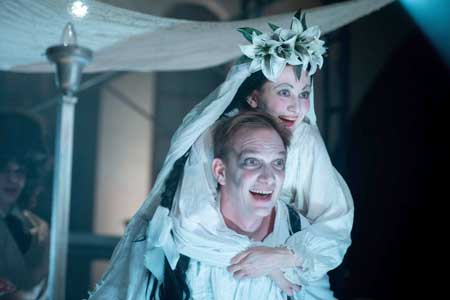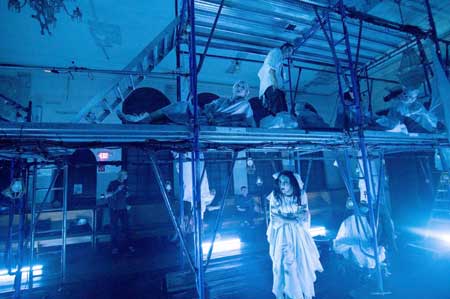Play (2024)
Written by Roy Chen
Based on the original play (2016) by S. Ansky
Directed by Igor Golyak
Adapted by Igor Golyak and Dr. Rachel Merrill Moss
With additional material from the translation by Joachim Neugroschel
Arlekin Players Theatre
The Vilna Shul, Boston’s Center for Jewish Culture
Beacon Hill, Boston
May 30 – June 30, 2024
Scenic Design: Igor Golyak and Sasha Kuznetsova; Lighting Design: Jeff Adelberg; Composer, Sound Design: Fedor Zhuravlev; Costume & Props Design: Sasha Ageeva
With Andrey Burkovskiy (Khonen, The Dybbuk), Yana Gladkikh (Leah), Deb Martin (Frade), Robert Walsh (Sender), Fedor Zhuravlev (Menashe), Boris Furman (Rabbi), Gene Ravvin (Rabbi Azriel), Olga Aronova, Jenya Brodskaia, Polina Dubovikova, Anna Furman, Rimma Gluzman, Juliya Shikh, Olga Sokolova, Irina Vilenchikv

Andrey Burkovskiy as Khonen
Yana Gladkikh as Leah
in “The Dybbuk”
Photo: Irina Danilova
Courtesy of Arlekin Players Theatre
Khonen (Andrey Burkovskiy) is in love with Leah (Yana Gladkikh) and pursues her, but, perhaps as a result of his involvement with the the lore of the mystical Judaic texts of the Kabbalah and influenced by related eerie forces, suddenly dies. Some months later, under the significant influence of her father, Sender (Robert Walsh), Leah, hotly pursued by a series of suitors, has been set to marry Menashe (Fedor Zhuravlev). But when the wedding comes and Leah is about to take her vows, a strange male voice emanates from her throat, and it is deemed that she is inhabited by a dybbuk. An exorcism is arranged and in the process of investigating the background of the families, it is determined that Sender and Khonen’s father, Nisan, had formed a pact before the birth of their children that their son and daughter would be betrothed. But, it turns out that Sender has reneged on the agreement because Nisan and his son Khonen were not well enough off, and this betrayal consequently was thought to have caused grievances in the spirit realm. The rabbinical court forgives Sender for his abandonment on his agreement with Nisan and an exorcism is arranged, theoretically releasing Leah from possession by Khonen’s ghost and freeing her to marry Menashe. But, despite the success of the exorcism, Leah’s love for Khonen is so deep and their connection so profound that she leaves this life to join him in death.
Indeed this is a spooky tale, and, on its own terms a kind of strange story, featuring the oddest and most unsettling myths about Jewish spiritualism. Yet, this production of the Arlekin Players is brilliantly conceived, and timed with astute sense of its subliminal relevance. The spookiness of the plot might well at other times seem bizarrely antiquated and completely unrelated to the contemporary world. At the present, however, in the midst of the devastation of wars both in Israel and Gaza and in the Ukraine, this subject and theme come across, obliquely but viscerally, very much to the point. In the midst of life and death, with daily reports of significant losses of life in both the Middle East and in Eastern Europe, this tale of the haunting spirit of those who have died seems eminently poignant and evocative.

Photo: Irina Danilova
Courtesy of Arlekin Players Theatre
The brilliance of this production is what characterizes a lot of what Arlekin seeks to do in its productions – to create a mood replete with a contemporary tension, a sense of that which rises up beyond the plot and the characterizations to convey what otherwise is hard to name. This production is, in so many ways, staged in a dramatically unhinged way, with scads of plastic streaming over the scaffolds that soar to the rafters, with lighting that comes from strung contractor lanterns and strong flashlights, and with costumes that are intentionally otherworldly. The overall effect is that normality is blown away to allow a breeze of some other overriding sort to come through and the effect is magical.
The production is set in the somewhat unrestored sanctuary of The Vilna Shul, a century-old Yiddishkeit synagogue on Beacon Hill in Boston which has in recent years been adopted by a community which has been intent to tend and to preserve it. This setting for this play is ideal – with half-evident as yet unrestored murals on the walls, with high perches and ceiling windows looming above, conveying a deep sense of history, the atmosphere rich and enveloping. Indeed this setting calls to mind both the destroyed buildings in the cities of the Ukraine, and those of homes, hospitals, mosques, and kibbutzim recently decimated in Gaza and Israel, and, of course, the many synagogues destroyed during the Holocaust. Though nowhere do the script or the production overtly suggest these associations, their overall energy, mood and disposition subliminally but vividly call these forth.
The direction by Igor Golyak is clearly inspired and visionary and draws from the large cast uniformly expressive and scintillating results. The leads, Andrey Burkovskiy as the Dybbuk and Yana Gladkikh as Leah, are pitched to a dramatic high C – everything they do is full of verve and charismatic intensity. As well, the supporting second tier, with Robert Walsh, the noted long-term Boston area actor and director as Sender, and the brilliantly pointed established Boston actor Deb Martin as Frade, fill out the drama with stringency and pizzazz.
The widely varied music and sound design by Fedor Zhuravlev range from melodic to tyrannic and are supremely effective in bringing about the meshed sense of community, romance, connection and devastation and is hauntingly appropriate throughout. As mentioned, Igor Golyak’s set design of scaffolding that rises up into the stratospheric roof and skylights of The Vilna Shul and the setting of the shul itself are brilliant choices, and overall the effect is mesmerizing.
Again, the poetry of this bold dramatic venture is so tied up with the state of the world at present and so emotively relevant to its demands makes this production the artistic gift that it is. Reaching towards us obliquely, through an intense angular tonality, it offers a visceral exercise during this time of woe and confusion, and, as such, it is indeed a gift, a work of dramatic art that probes the world and touches us where we hurt.
– BADMan (aka Charles Munitz)
Leave a Reply